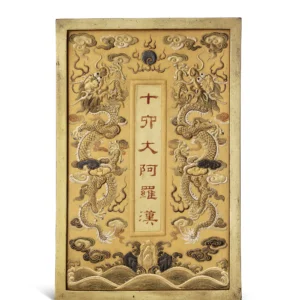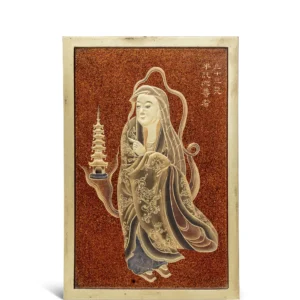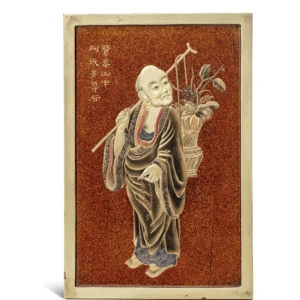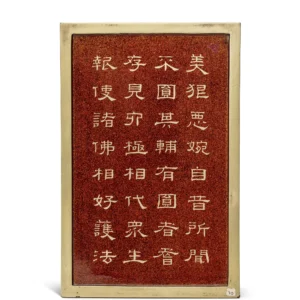Shi Liu Da A Luo Han – “Sixteen Great Arhat
CHINA - QIANLONG period (1736-1795)
Estimate : 30 000 - 50 000 €
Sold 440 000 €
Shi Liu Da A Luo Han – “Sixteen Great Arhats” rare and exceptional zitan wood box, consisting of a base with four uprights onto which a lid fits. Fully covered, it is decorated with inlaid motifs in mother-of-pearl, lapis lazuli, turquoise, ivory, agate, amber, fine pearls, tortoise shell, coral, cinnabar lacquer and tourmaline. On the upper face, six Chinese characters inlaid in mother-of-pearl in a cartouche, Shi Liu Da A Luo Han, meaning “Sixteen great Arhats”, are surrounded by the eight precious Buddhist objects: the victory banner, the fish, the vase, the lotus flower, the wheel, the parasol, the conch shell and the endless knot. The sides are adorned with movable objects including ruyi, incense burner, books, scroll, vase, fan and lotus, as well as Buddhist ritual objects such as the vajra, swallow, hand banner inscribed with “Amitayus”, pagoda, sword of possession and khakkhara.
The lower inner part of the box is lined with yellow silk.
This box, whose base is slightly narrowed to fit into a pedestal, would originally have rested on a lotiform base, similar to those found on some imperial boxes.
This box contains eighteen gold lacquer and aventurine plaques, sixteen featuring the Luohan, preceded by a plaque bearing the title of the lid, Shi Liu Da A Luo Han, in red lacquer, framed by two five-clawed dragons pursuing the sacred pearl. The reverse features Skanda (Wei Tuo), protector of the Buddha and guardian of the Buddhist monastery, on an aventurine background. The last plate in the series depicts Buddha Shakyamuni, founder of Buddhism, seated in meditation on a lotus. The reverse is gilded and free of all representations.
The remaining sixteen panels feature the Arhat (Luohan in Chinese), accompanied by calligraphy on the reverse. The Arhat are as follows:
1. Pindola-bharadvaja
2. Kanaka-vatsa
3. Kanaka-bharadvaja
4. Suvinda
5. Nakula
6. Bhadra
7. Karika
8. Kasyapa
9. Svaka
10. Panthaka
11. Rahula
12. Nagasena
13. Ingata
14. Vanavasin
15. Ajita
16. Pindola-Bharadvaja
Sometimes dreamy, sometimes smiling, each Arhat is depicted with gentleness and elegance, expressing serenity. Each is accompanied by an inscription enabling its identification. The talent of the artists behind these lacquers is expressed through the fine details of the clothes caught in the wind or in movement, the expressions on the faces, and the delicate light relief carving of the lacquer.
The calligraphy on the backs of the panels forms the poem “Praise for the Sixteen Luohan Paintings of Guan Xiu (832-912)” (Guan Xiu Shi Liu Luohan zan ci) by the poet Su Shi (1037-1101), which has been divided into sixteen paragraphs spread across all sixteen panels.
Condition:
(Damage to wood, missing inlays, fine cracks and deformations on the panels)
Box size: 23 x 16.3 x 16 cm
Panel size: 20.8 x 13.7 x 0.7 cm
About the iconography:
The Arhat (in Sanskrit) or Luohan (in Chinese) are considered to be the Buddha’s disciples who have attained enlightenment as a result of the Buddha’s teachings. They are usually depicted in series of 6, 8, 16, 18, or even 100 or 500, depending on the various Buddhist traditions.
The earliest known representations of Arhats date back to the end of the Northern and Southern Dynasties between 465 and 471 AD. Then, under the Northern Wei dynasty, two representations have come down to us from the Qian Xi temple.
The theme of the sixteen Arhats became common during the Tang period (618-907). It was the favorite subject of one of the great poets and painters of this period, Wang Wei (692-761). Later, the monk Guan Xiu (832-912) turned his attention to depictions of Buddha’s disciples, leaving us a large fresco in a temple near Hangzhou’s West Lake. It was in this temple that the poet Su Shi found the inspiration for his “Praise for Guan Xiu’s Painting of the Sixteen Luohans”, found on the reverse of our lacquer panels.
In 1757, the Qianlong emperor visited Hangzhou to admire the frescoes. Following this visit, he is said to have composed a poem in homage to these works. From then on, the subject of the sixteen Arhat became a favorite of the emperor. On the advice of his Buddhist master, he is said to have introduced the luohan Kasyapa (featured on one of the panels) into classical iconography.
About lacquerware:
In the Chinese empire, two great periods are renowned for the quality of their lacquerware: the period of the Warring Kingdoms (475-221 BC) and the period spanning the Ming (1368-1644) and Qing (1644-1912) dynasties. Lacquer is a demanding and fragile material, requiring a great deal of mastery in order to work it and render material and relief effects. Lacquer techniques using gold were the most difficult to master. These lacquers were so precious that they were reserved for the imperial family.
The panels here are representative of the virtuosity of Qing-period craftsmen, combining aventurine lacquer on the background with the Shiwen lacquer technique for the representation of luohan. The technique consisted in adding layers of lacquer to an already lacquered support, which were then carved to give a light relief effect.
This technique can be likened to Japanese lacquerware. Records from the 16th century mention that Japanese lacquers were already widely appreciated by Chinese scholars. The Ming dynasty greatly influenced the tastes of the Qing dynasty. So much so that Emperor Yongzheng (1722-1735) was known to be a great lover of Japanese lacquerware. He therefore asked his craftsmen to use the same techniques, or to come close to them, to make objects similar to those produced in Japan. His successor, the emperor Qianlong (1735-1796), followed suit.
Two objects in the Qing royal collection at the Forbidden City Museum in Beijing illustrate this taste for Japanese-style lacquerwork: a lacquered screen depicting the Minghuang emperor trying out a horse; and a travel cabinet with landscape motifs using the Shiwen technique.
The combination of inlay techniques, the preciousness of the materials used, and the extreme delicacy and finesse of the lacquer panels make this set truly exceptional.
Shi Liu Da A Luo Han – “Sixteen Great Arhat - CHINA - QIANLONG period (1736-1795)

Shi Liu Da A Luo Han – “Sixteen Great Arhat - CHINA - QIANLONG period (1736-1795)
Other results obtained by Asium
The Asium estimation service is...

Simple
and free
A few photos of your work, a few words of description and you're all set !

Fast
but not too fast
Our experts are serious, they take the time to research and get back to you within a week.

Reliable
and confidential
Our auctioneers are the Sherlock Holmes of the art market.








































